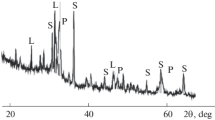Abstract
The chemical and mineral compositions of the gray and red slimes formed by the disintegration of silicon–titanium ores from the Pizhemskoe deposit are considered. The results of studying their hydrochloric acid leaching in 20% HCl in a temperature range of 40–200°C are presented. An increase in the leaching temperature leads to an increase in the access the slimes, which is related to the decomposition of a series of mineral phases. Siderite and goethite decompose at 40–100°C. The decomposition of the clay minerals occurs at temperatures of 90°C and higher. This process is accompanied by the formation of gel-like SiO2. Under pressure leaching conditions, pseudorutile, monazite, and xenotime simultaneously decompose together with the transition of cerium, neodymium, and yttrium to a solution. Complete decomposition of the minerals containing rare-earth metals is achieved at 180°C. The undecomposable solid residue is represented by rutile, quartz, amorphous SiO2, and zircon.





Similar content being viewed by others
REFERENCES
G. B. Sadykhov, “Fundamental problems and prospects of using titanium raw materials in Russia,” Izv. Vyssh. Uchebn. Zaved., Chern. Metall. 63 (3–4), 178–194 (2020).
A. B. Makeev, N. I. Bryanchaninova, and A. O. Krasotkina, “Unique titanium deposits of timan: problems of genesis and age,” Zap. Gorn. Inst. 255, 275–289 (2022).
G. B. Sadykhov, A. B. Makeev, D. Y. Kopyev, K. G. Anisonyan, Ju. V. Zablotskaya, T. V. Olyunina, and B. G. Balmaev, “Mineralogical and technological features of the titanium-bearing sandstones of the Pizhemskoye deposit,” Russ. Metall. (Metally), No. 9, 1143–1154 (2021).
E. A. Walpole and J. D. Winter, The Austpac ERMS and EARS Processes for the Manufacture of High-Grade Artificial Rutile by the Hydrochloric Acid Leaching of Ilmenite (Austpac Resources N.L., NSW, Sydney, 2002).
S. G. Skublov, A. B. Makeev, A. O. Krasotkina, S. E. Borisovskii, X. H. Li, and Q. L. Li, “Isotopic geochemical features of zircon from the Pizhemskoe titanium deposit (Middle Timan) as a reflection of hydrothermal processes,” Geokhimiya 67 (9), 807–829 (2022).
Yu. A. Lainer, Complex Processing of Aluminum-Containing Raw Materials by Acidic Methods (Nauka, Moscow, 1982).
V. A. Reznichenko, V. V. Averin, and T. V. Olyunina, Titanates: Scientific Foundations, Technology, and Manufacturing (Nauka, Moscow, 2010).
A. B. Makeev, “Typomorphic features of minerals of titanium ores of the Pizhemskoe deposit,” Mineralogiya, No. 1, 24–49 (2016).
Funding
This work was carried out in terms of state assignment no. 075-00715-22-00.
Author information
Authors and Affiliations
Corresponding author
Ethics declarations
The authors declare that they have no conflicts of interest.
Additional information
Translated by E. Yablonskaya
Rights and permissions
About this article
Cite this article
Anisonyan, K.G., Kop’ev, D.Y., Zablotskaya, Y.V. et al. Hydrochloric Acid Decomposition of the Clay Slimes of Silicon–Titanium Ores. Russ. Metall. 2023, 1–6 (2023). https://doi.org/10.1134/S0036029523010020
Received:
Revised:
Accepted:
Published:
Issue Date:
DOI: https://doi.org/10.1134/S0036029523010020



